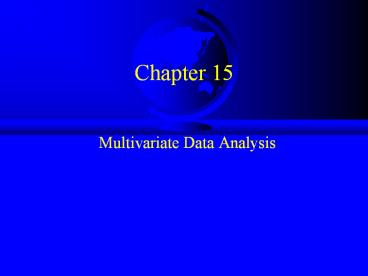Multivariate Data Analysis - PowerPoint PPT Presentation
1 / 11
Title:
Multivariate Data Analysis
Description:
It encompasses a set of computational procedures that can summarize an input ... Scree Plot: Plot of eigenvalues against number of factors. ... – PowerPoint PPT presentation
Number of Views:353
Avg rating:3.0/5.0
Title: Multivariate Data Analysis
1
Chapter 15
- Multivariate Data Analysis
2
- Interdependence Techniques
- Factor Analysis
- Technique in which researchers look for a small
number of factors that could explain the
correlation between a large number of variables - Cluster Analysis
- Variables are placed in subgroups or clusters
- Multidimensional Scaling
- It encompasses a set of computational procedures
that can summarize an input matrix of
associations between variables or objects in two
dimensional space
3
- Dependence Techniques
- Discriminant Analysis
- To find a linear combination of independent
variables that makes the mean scores across
categories of the dependent variable on this
linear combination m different - Conjoint Analysis
- Deals with the joint effects of two or more
independent variables on the ordering of a
dependent variable
4
- Factor Analysis
- Look for small set of factors to explain
correlation - between a large set of variables
- Used for data reduction and transformation
- Used in personality scales, identification of
key - product attributes, etc.
5
Factor Analysis (contd) Factor A variable or
a construct that is not directly observable but
needs to be inferred from input
variables Eigenvalue Amount of variance in
the original variables that are associated with
the factor
6
Factor Analysis (contd) Scree Plot Plot of
eigenvalues against number of factors. For
factors with large eigenvalues this plot has a
steep slope . Percentage of Variance Criteria
The number of factors extracted is determined
so that the cumulative percentage of variance
extracted by the variance reaches a
satisfactory level. Factor Score Value of
each factor for all respondents
7
- Disadvantages of Factor Analysis
- Subjective
- Does not make use of any standard
- statistical tests
8
- Cluster Analysis
- Group objects into clusters based on the
- attributes they possess.
- Objects that are similar placed in one group
- Groups have minimum within-group variability
and - maximum between-group variability.
9
- Multi-dimensional Scaling
- Creates a matrix associations between
variables - Used by marketers to study relationships
among objects, consumer perceptions, brand
preferences, and preferred product attributes.
10
- Discriminant Analysis
- Objective is to find a linear combination of
- independent variables that make the mean scores
- across categories of dependent variables on
this linear combination maximally different. - Used to classify objects into two or more
- alternative groups on the basis of a set of
- measurements
11
- Conjoint Analysis
- Measure joint effects of two or more
independent variables on the ordering of a
dependent variable - Quantitative measure of relative importance of
one attribute over another































